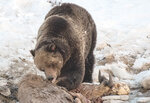Clear, 53° F
Grizzly bear population growth has slowed significantly in the Greater Yellowstone Ecosystem, only increasing slightly for the last decade, according to a U.S. Geological Survey official during an …
This item is available in full to subscribers.
The Powell Tribune has expanded its online content. To continue reading, you will need to either log in to your subscriber account, or purchase a subscription.
If you are a current print subscriber, you can set up a free web account by clicking here.
If you already have a web account, but need to reset it, you can do so by clicking here.
If you would like to purchase a subscription click here.
Please log in to continue |
|


Grizzly bear population growth has slowed significantly in the Greater Yellowstone Ecosystem, only increasing slightly for the last decade, according to a U.S. Geological Survey official during an Interagency Grizzly Bear Committee Wednesday in Cody.
It’s yet another “indicator that we’re kind of reaching that magical carrying capacity of the ecosystem,” said the committee’s study team leader Frank van Manen.
Grizzly bear population growth was largely stagnant, calculated at 0.9% between 2010 and 2020 according to population data gathered by the study team.
From 2000 to 2010, the population grew at a rate of 5.7%.
“It’s a totally natural process that you would expect to see in in any population that is reaching biological recovery,” he said.
The current rate of growth is up from that slightly since 2020, but van Manen said we aren’t far enough into the decade to draw any conclusions from estimates derived from the past two years. Recent data shows a 2.7% increase from 2021 through 2022, but van Manen said there is ample evidence that the Demographic Monitoring Area (DMA) — which encompasses the species’ recovery zone within the GYE and more than 8,880-square miles of suitable habitat around the Recovery Zone — is bursting at the seams. Evidence includes higher infant mortality due to adult bears killing cubs (known as infanticide). Kerry Guenther, bear management biologist for Yellowstone National Park, said data from the park has seen the same trend.
“Bears killed more bears in the park last year than we did,” he said. By “we” he meant death by human causes — everything from vehicle strikes to management removals.
There’s also a stagnant, if not receding, footprint of the species’ reach outside the boundaries of the DMA, which van Manen said shows they have reached “the limits of even marginal habitat” in the ecosystem.
Additional evidence includes a grizzly boar found to have traveled from the GYE to the Northern Continental Divide Ecosystem (NCDE) in Montana looking for a less crowded neighborhood. The boar was euthanized about two years ago in Montana for cattle depredation, but it took the past two years for DNA testing to be completed, revealing the boar was an enthusiastic traveler.
Connectivity with bears outside of the GYE is essential for conservation of the species, van Manen said. “Unfortunately, this bear was going the wrong way” for scientists seeking to diversify the gene pool of grizzlies in the GYE.
This comes at a time when conflict reports were lower in the past year than expected, but van Manen said an aggressive lethal removal and relocation campaign of problem bears in previous years is likely the reason conflicts dropped.
“If you can target those individuals, you can actually affect them for a number of years to reduce the number of subsequent conflicts. It’s a very effective management strategy,” he said.
The majority of conflicts now are site specific, largely associated with livestock depredation, from cattle and sheep, to chickens and beehives and livestock feed, van Manen said.
The Wyoming Game and Fish Department responded to 206 grizzly bear conflicts in 2022, said Wyoming’s Large Carnivore Conflict Coordinator Brian DeBolt. The data is from both inside and outside the Demographic Monitoring Area.
Yet, a large percentage of their work is educating the public to be bear aware and to increase tolerance of the species, especially on private land. The department walks a fine line due to a diversity in opinions in Wyoming and beyond, DeBolt said.
“There’s a huge spectrum of viewpoints out there, as we all know, from kill them all to save them all. And, you know, some people think, the only good bear is a dead bear and other folks think that even if a grizzly bear kills somebody, the bear’s life is worth far more than a human life,” he said during Thursday’s session, adding, “We try to avoid the torches and pitchforks types from either group.”
While population estimates only include bears within the DMA, a significant portion of conflicts are happening outside suitable habitat, DeBolt said.
“Bears are moving into places that for a long time have not been occupied by grizzly bears, and there’s a lot of human use activities there,” he said.
He echoed van Manen’s claim that the species is recovered in the GYE, saying it’s a “success story.”
“The amount of data that we have on GYE grizzly bears is phenomenal. And it just can’t come into question — the statistics and validity that these things are biologically recovered,” he said.
The Study Team has once again transitioned to a new math equation to estimate grizzly bear numbers, moving to an integrated population model which van Manen said is an improvement over the past method of counting females with cubs from aircraft. The new estimate is down about 100 bears, from 1,069 in previous estimates to 965 currently in the DMA.